Abstract
The apparent molal adiabatic compressibilities of ferri- and ferrocytochrome c have been determined from measurements of density and sound velocity. The values found were +2.99 X 10(-8) and -2.40 X 10(-8) cm5 mol-1 dyne-1 for the ferri and ferro forms, respectively. Experiments were performed on identical solutions containing either the oxidized or reduced form of protein. Solutions of ferricytochrome c were found to have significantly greater adiabatic compressibility than equivalent solutions of ferrocytochrome c at 25 degrees C and pH 7.15. The remarkable similarity of the three-dimensional structures of the ferri and ferro proteins [Takano, T. & Dickerson, R.E. (1980) Proc. Natl. Acad. Sci. USA 77, 6371-6375] strongly suggests that this difference in compressibility is due to an increase in volume fluctuations within ferricytochrome c relative to the ferro form rather than a change in equilibrium structure or hydration. Such a difference in the dynamic properties of the structures is consistent with both the crystallographic thermal B factors and the observed increase in amide hydrogen exchange kinetics when ferrocytochrome c is oxidized. The relative magnitude of the root mean square volume fluctuations is approximated from an ideal solution treatment of the compressibility data and yields a ratio of delta Vrms (ferri cyt c)/ delta Vrms (ferro cyt c) = 1.3.
Full text
PDF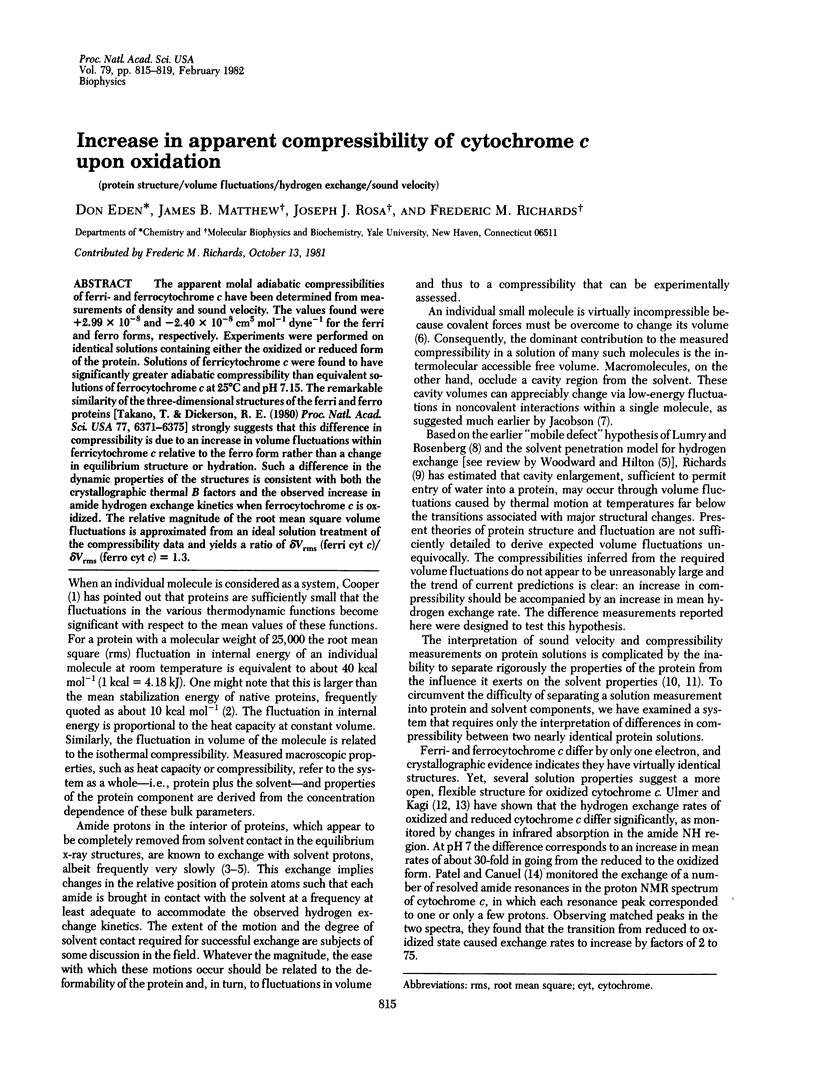
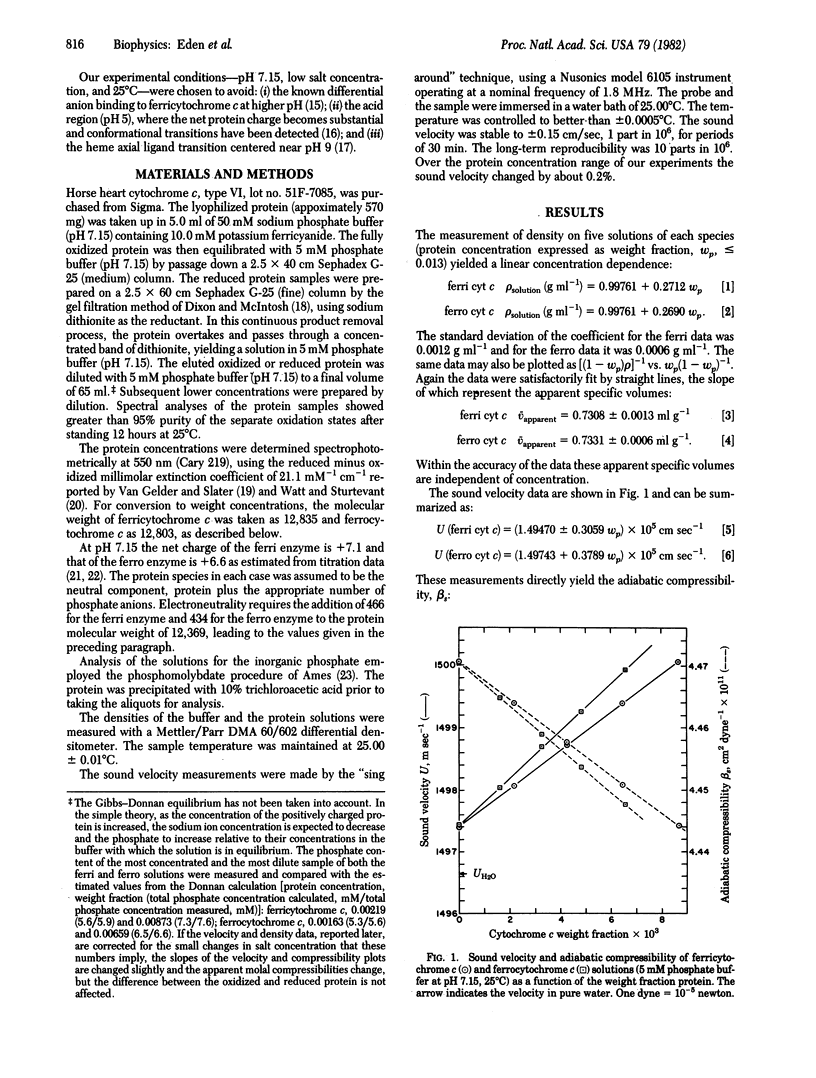
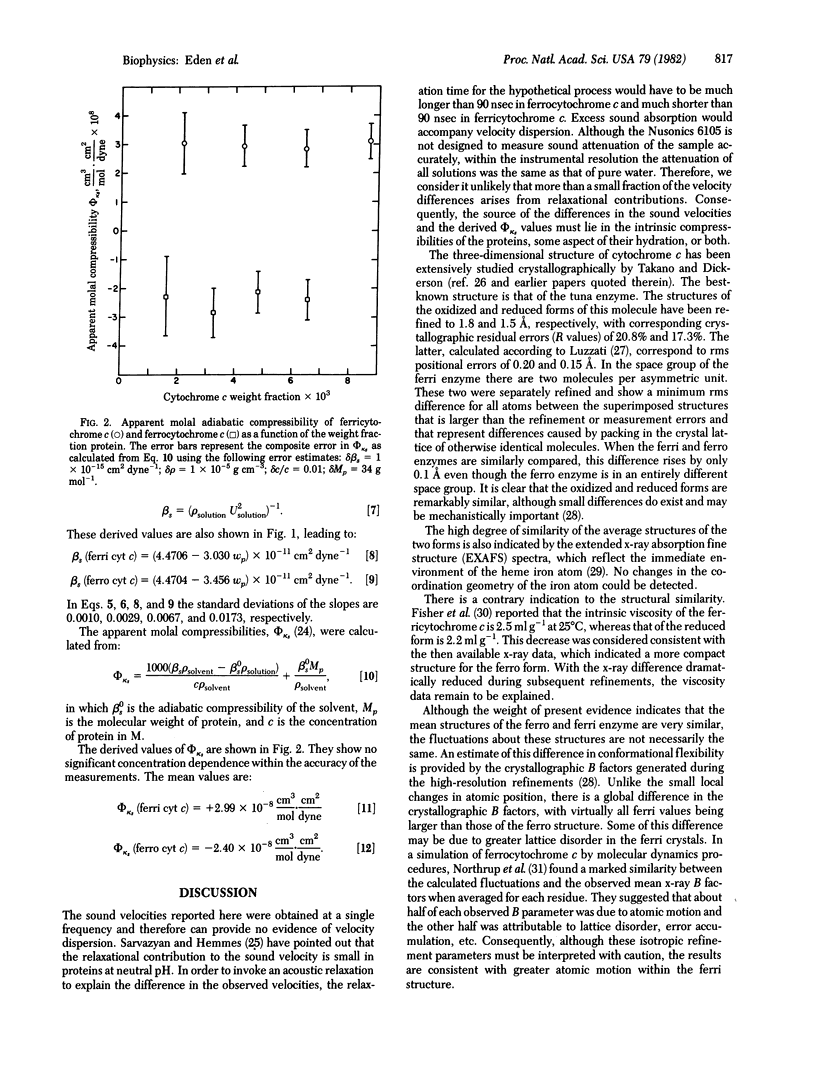
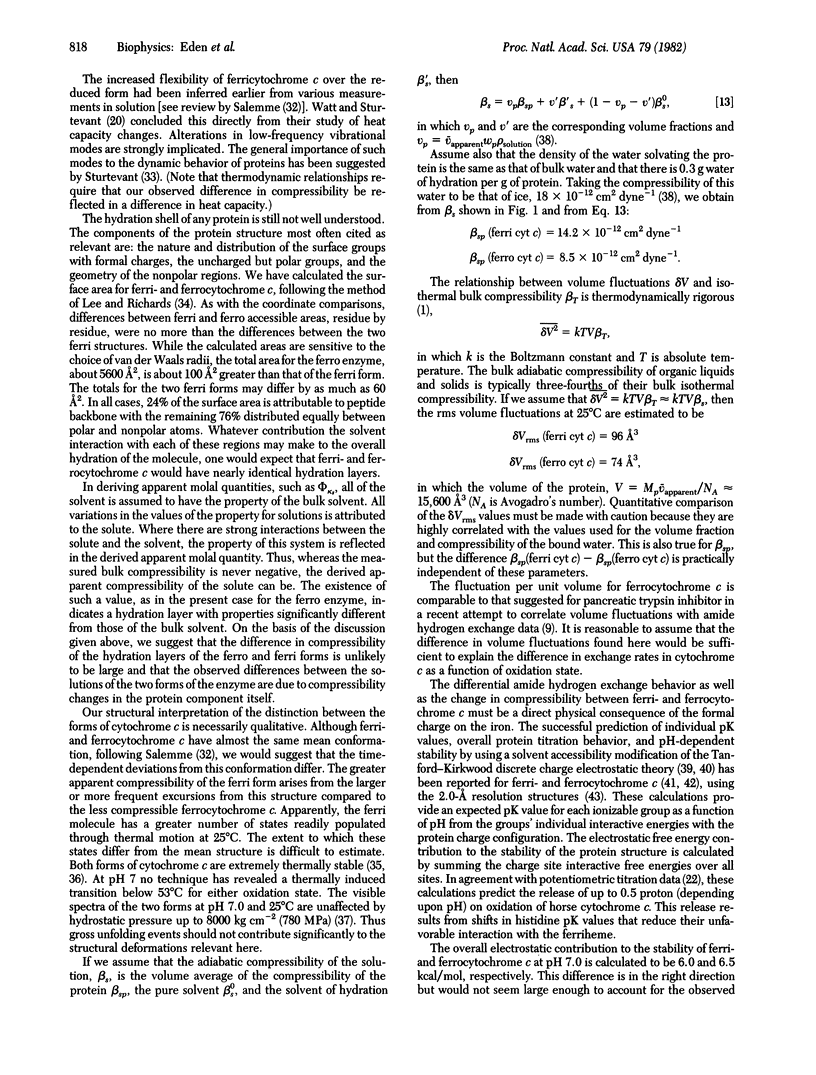
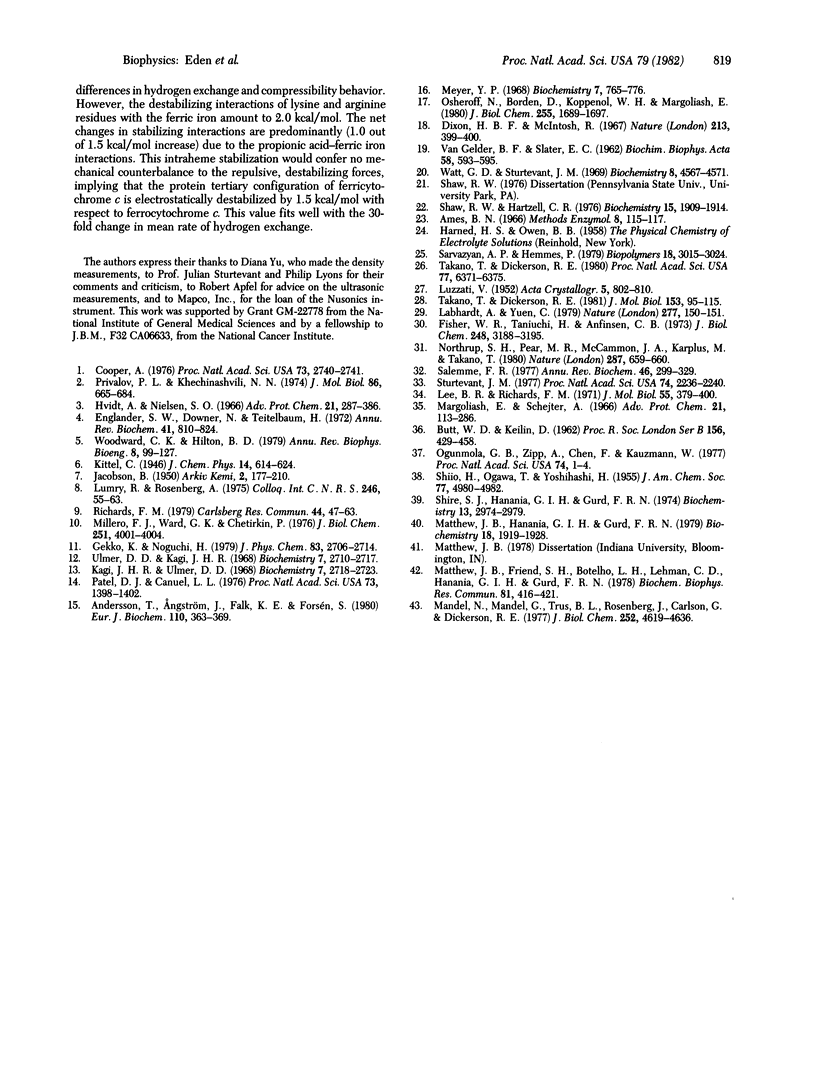
Selected References
These references are in PubMed. This may not be the complete list of references from this article.
- Andersson T., Angström J., Falk K. E., Forsén S. Perchlorate binding to cytochrome c: a magnetic and optical study. Eur J Biochem. 1980 Sep;110(2):363–369. doi: 10.1111/j.1432-1033.1980.tb04876.x. [DOI] [PubMed] [Google Scholar]
- BUTT W. D., KEILIN D. Absorption spectra and some other properties of cytochrome c and of its compounds with ligands. Proc R Soc Lond B Biol Sci. 1962 Nov 20;156:429–458. doi: 10.1098/rspb.1962.0049. [DOI] [PubMed] [Google Scholar]
- Cooper A. Thermodynamic fluctuations in protein molecules. Proc Natl Acad Sci U S A. 1976 Aug;73(8):2740–2741. doi: 10.1073/pnas.73.8.2740. [DOI] [PMC free article] [PubMed] [Google Scholar]
- Dixon H. B., McIntosh R. Reduction of methaemoglobin in haemoglobin samples using gel filtration for continuous removal of reaction products. Nature. 1967 Jan 28;213(5074):399–400. doi: 10.1038/213399a0. [DOI] [PubMed] [Google Scholar]
- Fisher W. R., Taniuchi H., Anfinsen C. B. On the role of heme in the formation of the structure of cytochrome c. J Biol Chem. 1973 May 10;248(9):3188–3195. [PubMed] [Google Scholar]
- Hvidt A., Nielsen S. O. Hydrogen exchange in proteins. Adv Protein Chem. 1966;21:287–386. doi: 10.1016/s0065-3233(08)60129-1. [DOI] [PubMed] [Google Scholar]
- Kägi J. H., Ulmer D. D. Hydrogen-deuterium exchange of cytochrome c. II. Effect of pH. Biochemistry. 1968 Aug;7(8):2718–2723. doi: 10.1021/bi00848a004. [DOI] [PubMed] [Google Scholar]
- Labhardt A., Yuen C. X-ray absorption edge fine structure spectroscopy of the active site haem of cytochrome c. Nature. 1979 Jan 11;277(5692):150–151. doi: 10.1038/277150a0. [DOI] [PubMed] [Google Scholar]
- Lee B., Richards F. M. The interpretation of protein structures: estimation of static accessibility. J Mol Biol. 1971 Feb 14;55(3):379–400. doi: 10.1016/0022-2836(71)90324-x. [DOI] [PubMed] [Google Scholar]
- Mandel N., Mandel G., Trus B. L., Rosenberg J., Carlson G., Dickerson R. E. Tuna cytochrome c at 2.0 A resolution. III. Coordinate optimization and comparison of structures. J Biol Chem. 1977 Jul 10;252(13):4619–4636. [PubMed] [Google Scholar]
- Margoliash E., Schejter A. Cytochrome c. Adv Protein Chem. 1966;21:113–286. doi: 10.1016/s0065-3233(08)60128-x. [DOI] [PubMed] [Google Scholar]
- Matthew J. B., Friend S. H., Botelho L. H., Lehman L. D., Hanania G. I., Gurd F. R. Discrete charge calculations of potentiometric titrations for globular proteins: sperm whale myoglobin, hemoglobin alpha chain, cytochrome c. Biochem Biophys Res Commun. 1978 Mar 30;81(2):416–421. doi: 10.1016/0006-291x(78)91549-8. [DOI] [PubMed] [Google Scholar]
- Matthew J. B., Hanania G. I., Gurd F. R. Electrostatic effects in hemoglobin: hydrogen ion equilibria in human deoxy- and oxyhemoglobin A. Biochemistry. 1979 May 15;18(10):1919–1928. doi: 10.1021/bi00577a011. [DOI] [PubMed] [Google Scholar]
- Millero F. J., Ward G. K., Chetirkin P. Partial specific volume, expansibility, compressibility, and heat capacity of aqueous lysozyme solutions. J Biol Chem. 1976 Jul 10;251(13):4001–4004. [PubMed] [Google Scholar]
- Myer Y. P. Conformation of cytochromes. 3. Effect of urea, temperature, extrinsic ligands, and pH variation on the conformation of horse heart ferricytochrome c. Biochemistry. 1968 Feb;7(2):765–776. doi: 10.1021/bi00842a035. [DOI] [PubMed] [Google Scholar]
- Northrup S. H., Pear M. R., McCammon J. A., Karplus M., Takano T. Internal mobility of ferrocytochrome c. Nature. 1980 Oct 16;287(5783):659–660. doi: 10.1038/287659a0. [DOI] [PubMed] [Google Scholar]
- Ogunmola G. B., Zipp A., Chen F., Kauzmann W. Effects of pressure on visible spectra of complexes of myoglobin, hemoglobin, cytochrome c, and horse radish peroxidase. Proc Natl Acad Sci U S A. 1977 Jan;74(1):1–4. doi: 10.1073/pnas.74.1.1. [DOI] [PMC free article] [PubMed] [Google Scholar]
- Osheroff N., Borden D., Koppenol W. H., Margoliash E. Electrostatic interactions in cytochrome c. The role of interactions between residues 13 and 90 and residues 79 and 47 in stabilizing the heme crevice structure. J Biol Chem. 1980 Feb 25;255(4):1689–1697. [PubMed] [Google Scholar]
- Patel D. J., Canuel L. L. Nuclear magnetic resonance studies of slowly exchanging peptide protons in cytochrome c in aqueous solution. Proc Natl Acad Sci U S A. 1976 May;73(5):1398–1402. doi: 10.1073/pnas.73.5.1398. [DOI] [PMC free article] [PubMed] [Google Scholar]
- Privalov P. L., Khechinashvili N. N. A thermodynamic approach to the problem of stabilization of globular protein structure: a calorimetric study. J Mol Biol. 1974 Jul 5;86(3):665–684. doi: 10.1016/0022-2836(74)90188-0. [DOI] [PubMed] [Google Scholar]
- Rosenberg S. A., Kaplan H. S. The management of stages I, II, and III Hodgkin's disease with combined radiotherapy and chemotherapy. Cancer. 1975 Jan;35(1):55–63. doi: 10.1002/1097-0142(197501)35:1<55::aid-cncr2820350108>3.0.co;2-g. [DOI] [PubMed] [Google Scholar]
- Salemme F. R. Structure and function of cytochromes c. Annu Rev Biochem. 1977;46:299–329. doi: 10.1146/annurev.bi.46.070177.001503. [DOI] [PubMed] [Google Scholar]
- Shaw R. W., Hartzell C. R. Hydrogen ion titration of horse heart ferricytochrome c. Biochemistry. 1976 May 4;15(9):1909–1914. doi: 10.1021/bi00654a018. [DOI] [PubMed] [Google Scholar]
- Shire S. J., Hanania G. I., Gurd F. R. Electrostatic effects in myoglobin. pH and ionic strength variations of ionization equilibria for individual groups in sperm whale ferrimyoglobin. Biochemistry. 1974 Jul 2;13(14):2974–2979. doi: 10.1021/bi00711a029. [DOI] [PubMed] [Google Scholar]
- Sturtevant J. M. Heat capacity and entropy changes in processes involving proteins. Proc Natl Acad Sci U S A. 1977 Jun;74(6):2236–2240. doi: 10.1073/pnas.74.6.2236. [DOI] [PMC free article] [PubMed] [Google Scholar]
- Takano T., Dickerson R. E. Conformation change of cytochrome c. II. Ferricytochrome c refinement at 1.8 A and comparison with the ferrocytochrome structure. J Mol Biol. 1981 Nov 25;153(1):95–115. doi: 10.1016/0022-2836(81)90529-5. [DOI] [PubMed] [Google Scholar]
- Takano T., Dickerson R. E. Redox conformation changes in refined tuna cytochrome c. Proc Natl Acad Sci U S A. 1980 Nov;77(11):6371–6375. doi: 10.1073/pnas.77.11.6371. [DOI] [PMC free article] [PubMed] [Google Scholar]
- Ulmer D. D., Kägi J. H. Hydrogen-deuterium exchange of cytochrome c. I. Effect of oxidation state. Biochemistry. 1968 Aug;7(8):2710–2717. doi: 10.1021/bi00848a003. [DOI] [PubMed] [Google Scholar]
- Watt G. D., Sturtevant J. M. The enthalpy change accompanying the oxidation of ferrocytochrome c in the pH range 6-11 at 25 degrees. Biochemistry. 1969 Nov;8(11):4567–4571. doi: 10.1021/bi00839a050. [DOI] [PubMed] [Google Scholar]
- Woodward C. K., Hilton B. D. Hydrogen exchange kinetics and internal motions in proteins and nucleic acids. Annu Rev Biophys Bioeng. 1979;8:99–127. doi: 10.1146/annurev.bb.08.060179.000531. [DOI] [PubMed] [Google Scholar]
- van GELDER B., SLATER E. C. The extinction coefficient of cytochrome c. Biochim Biophys Acta. 1962 Apr 23;58:593–595. doi: 10.1016/0006-3002(62)90073-2. [DOI] [PubMed] [Google Scholar]


